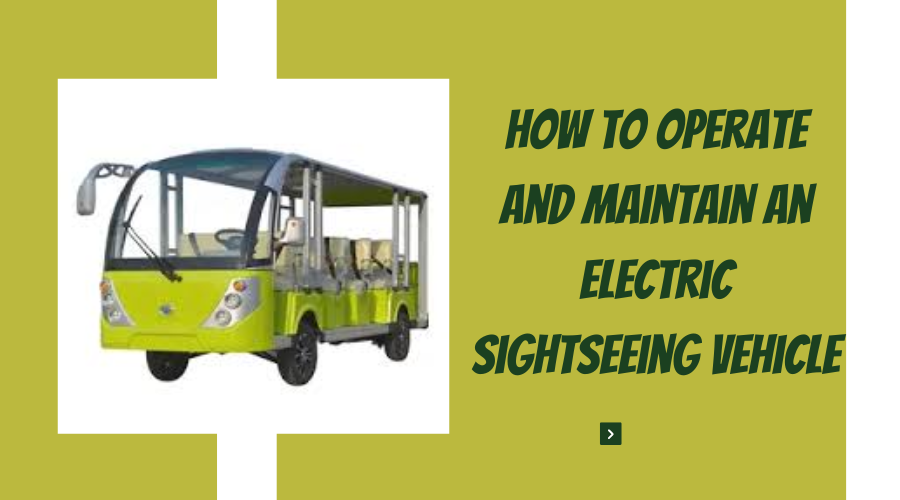
The popularity of electric sightseeing vehicles for tourists and operators is steadily rising, and they have become the preferred touring option since they do not spread pollution, which is excellent for maintaining the quality of natural landscapes. Urban landscapes, national parks, and cultural sites can be navigated silently, smoothly, and sustainably, so this is also a plus point. As such, drivers need to understand the characteristics of electric vehicles, handle them correctly, and keep them in good working order to ensure that they operate safely, comfortably, and with maximum efficiency.
This all-inclusive guide discusses all driving electric sightseeing vehicles, from simple controls to safety tips and maintenance guidelines.
➣ Power on: Electric vehicles usually have a power button or a key to start them. Once the button is pressed, the control panel display also turns on.
➣ Battery Level Check: Before starting the trip, a key element to check is the battery charge. The remaining battery charge percentage is reflected in the battery gauge on the control panel.
➣ Mirror and Seat Alignment: A precise viewing angle is necessary for safe driving, and mirrors and seats should be adjusted accordingly to ensure no blind corners.
➣ Accelerating: The basic controls of an electric sightseeing vehicle are similar to those of a traditional car. For acceleration, there is a foot pedal that can be pressed to speed up the car.
➣ Steering: Turning the steering wheel in a particular direction is enough to control the car's direction during a ride.
➣ Speed Setting: Electric sightseeing cars have additional settings that limit a vehicle's speed. This is a valuable option since many sightseeing vehicles are used to tour the area, and a fast speed is unnecessary.
➣ Reverse Gear: reversing is effortless since electric sightseeing vehicles feature reverse Gear.
Driving and running an electric sightseeing vehicle is pretty straightforward. Most electric-powered automobile models have consumer-pleasant controls, and the learning curve to use them is not steep, so even a first-time user can get familiar with them pretty fast.
➣ To start an electric sightseeing vehicle, turn the ignition switch to the "on" position. Most electric cars have an on/off button or critical ignition system. Once you've turned it on, wait for dashboard signals to indicate the vehicle is ready to operate.
➣ Press the acceleration pedal slowly. Increase your speed gradually to avoid jerky movements, especially when carrying passengers.
➣ Turning in an electric sightseeing vehicle is much like any other vehicle. Still, due to its quieter operation, you must frequently use your mirrors and signal lights to inform other drivers or pedestrians of your intentions.
➣ Take corners slowly and avoid sharp turns, which could unbalance the vehicle or discomfort passengers.
➣ Press the brake pedal quickly while you want to sluggish down or forestall. Avoid surprising braking until necessary, as it can be uncomfortable for passengers and could cause injuries in slippery conditions.
➣ Parking an electric sightseeing vehicle is straightforward. When ready to park, press the brake pedal absolutely, come to a complete stop, and then turn off the ignition transfer.
Always ensure the automobile is parked on stage ground and in no way goes away, running unattended.
Additionally, some cars may also have a parking brake. If so, interact with it after turning off the vehicle for added protection.
Electric sightseeing cars are used heavily and need to be maintained properly for continuity of service and maximum productivity.
➣ Pre-trip inspection: The inspection should be comprehensive and cover brakes, steering, tires, lights, and battery charge levels.
➣ Following speed limits: Accidents are always present, even during sightseeing. Always follow designated speed limits or suitable speeds in areas with heavy traffic.
➣ Follow Pedestrian Zone Rules: It is crucial to be careful of pedestrians while driving an electric vehicle, especially in parks, zoos, or tourist areas.
➣ Refrain from overloading: Adhere to the manufacturer's loadbearing limits on passenger weight or load capacity. Overloading will negatively affect ride quality.
➣ Drive smoothly: Jerky movements, jerky turns, or screeching brakes cause discomfort and, occasionally, accidents. Let's ensure that a smooth, accident-free ride reaches the passengers.
Electric vehicle maintenance is much easier than internal combustion engine-based vehicles, but periodic checks must still be performed to keep them in top condition. This would entail the following:
➣ Check battery condition: Scan the battery for signs of wear, corrosion, or damage and replace old batteries accordingly.
➣ Brake lubrication: Grease the brake and adjust if necessary.
➣ Tire pressure: Check tire pressures regularly to ensure the best performance and safety. Inflated tires give you a smoother ride and reduce battery strain.
➣ Clean: Clean the vehicle, especially the battery terminals and connections, so that they are neither dirty nor corroded.
Operating an electric sightseeing vehicle is a pleasant, accessible, and friendly transportation for people through scenic areas; by gaining insight into simple controls and safety instructions and maintaining the car, you guarantee smooth, safe, and efficient operation.
Electric cars are yet another alternative and sustainable mode of transport—a perfect fit for tourist attractions, parks, or resorts. If cared for and used correctly, they can last many years without environmental pollution.